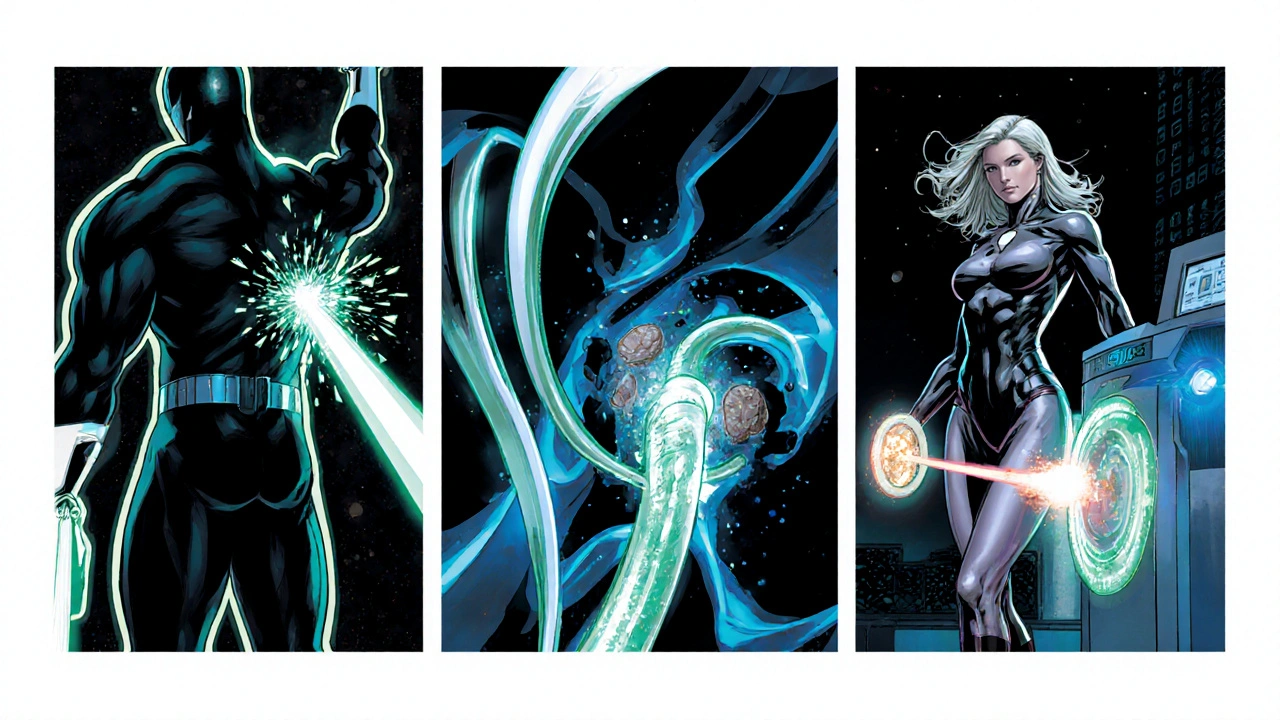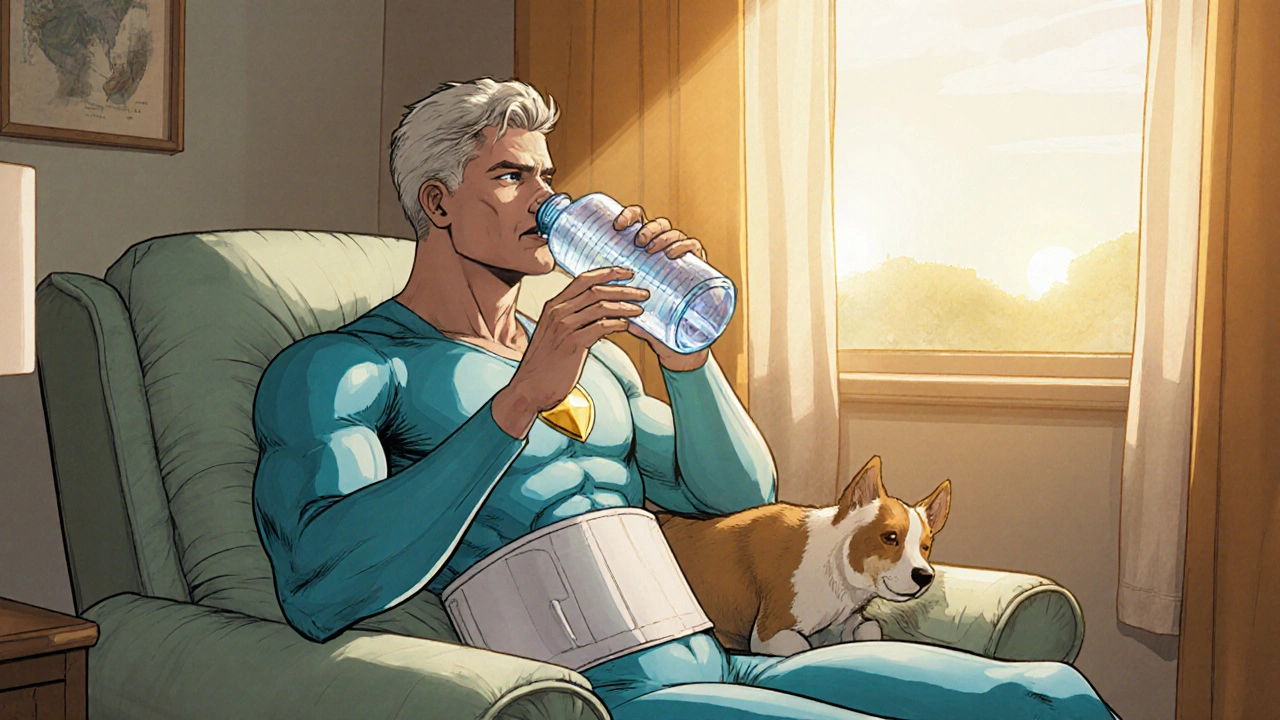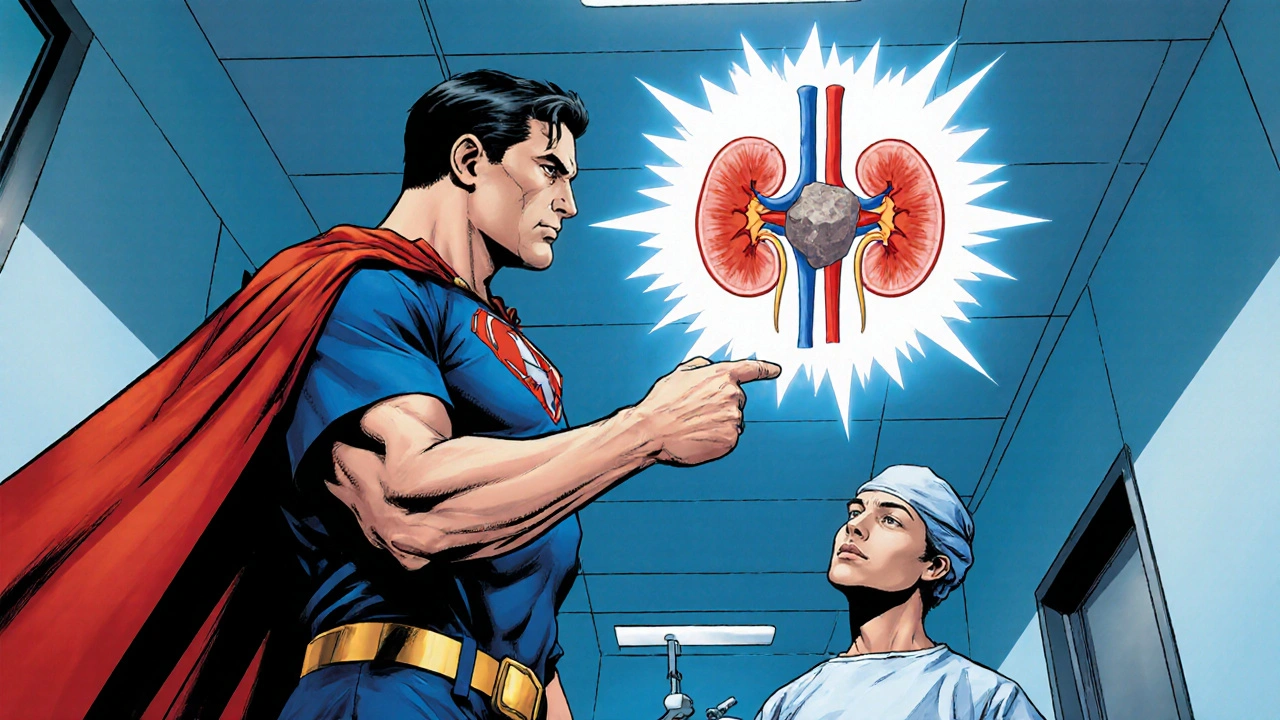Kidney Stone Surgery Recovery Calculator
Find Your Recovery Expectations
Select your procedure type and recovery day to see what to expect during your recovery.
Select your surgery type and recovery day to see personalized recovery expectations.
Finding out you need surgery for a kidney stone can feel overwhelming. You probably wonder how the procedure works, what you should do beforehand, and how long it will take to get back to normal. This guide breaks down everything you need to know, from the basics of the operation to day‑of tips and a realistic recovery timeline.
What Is Kidney Stone Surgery?
Kidney Stone Surgery is a surgical procedure designed to remove or break up kidney stones that are too large, too hard, or causing severe pain that can’t be managed with medication or lifestyle changes. The goal is to clear the urinary tract, relieve pain, and protect kidney function. Surgeons choose the technique based on stone size, location, and your overall health.
Types of Kidney Stone Surgery
Three main approaches dominate modern practice. Each has its own strengths, drawbacks, and typical recovery windows.
| Procedure | Invasiveness | Typical Recovery | Success Rate |
|---|---|---|---|
| Percutaneous Nephrolithotomy (PCNL) | Minimally invasive but requires a small incision in the back | 1-2 weeks for most activities; 4-6 weeks before heavy lifting | 85‑95% for stones >2cm |
| Ureteroscopy | Endoscopic, passed through the urethra and bladder | 2-5 days for light activity; full recovery in 1-2 weeks | 80‑90% for stones ≤2cm |
| Shock Wave Lithotripsy | Non‑invasive, uses focused sound waves outside the body | Same‑day discharge; pain may last a few days | 60‑70% for stones ≤2cm (may need repeat session) |
Choosing the right method depends on the stone’s size, its position in the Renal Pelvis (the funnel that feeds the ureter) or deeper in the Ureter, the narrow tube that carries urine to the bladder, as well as your overall health and personal preferences.
How to Prepare Before Surgery
Good preparation reduces anxiety and improves outcomes. Follow this checklist:
- Medical Evaluation: Your urologist will order imaging (CT scan or ultrasound) to map the stone’s exact location.
- Blood Work: Tests for kidney function, clotting ability, and infection markers are standard.
- Medication Review: Stop blood thinners (e.g., warfarin, aspirin) several days before unless your doctor says otherwise. Discuss any supplements, especially vitaminC or calcium, as they can affect stone formation.
- Fasting: Most hospitals require no food or drink after midnight before a morning operation. Follow the specific instructions given by your surgical team.
- Pre‑Op Instructions: Arrange transportation, clear your schedule for at least 24hours post‑procedure, and keep a list of emergency contacts.
- Home Prep: Stock up on easy‑to‑digest foods (soups, smoothies), pain medication, and a comfortable place to rest.
If you’re undergoing PCNL, you may also need a pre‑operative chest X‑ray to ensure the lungs are clear, as the surgery involves a brief period of anesthesia with a breathing tube.

What Happens on the Day of Surgery
Here’s a step‑by‑step walk‑through of a typical day:
- Check‑In: You’ll be greeted by a nurse, verify your identity, and sign consent forms.
- Pre‑Op Area: An IV line is placed, and a brief interview confirms no new allergies or medications.
- Anesthesia: An Anesthesiologist will discuss whether you’ll receive general anesthesia (you’ll be asleep) or regional/local anesthesia (you’ll be comfortable but awake). Most kidney stone surgeries use general anesthesia.
- Procedure:
- Percutaneous Nephrolithotomy: A small incision is made in the back. A tiny camera (nephroscope) is inserted, and the stone is broken into fragments using ultrasonic or laser devices.
- Ureteroscopy: A thin scope travels up the urethra, into the bladder, and up the ureter. The stone is either retrieved with a basket or pulverized with a laser.
- Shock Wave Lithotripsy: You lie on a padded table while a machine fires focused sound waves at the stone. The shocks fragment the stone, which then passes naturally.
- Recovery Room: You’ll spend 30-60 minutes waking up, with nurses monitoring vitals and pain levels.
- Discharge: Most patients go home the same day after SWL or ureteroscopy. PCNL often requires an overnight stay to monitor for bleeding.
During the entire process, a Radiologist may be present to guide imaging, especially for PCNL where precise needle placement is crucial.
Recovery Timeline and Aftercare
Recovery isn’t one‑size‑fits‑all. Below is a realistic timeline for the three procedures:
| Day | Ureteroscopy | Percutaneous Nephrolithotomy | Shock Wave Lithotripsy |
|---|---|---|---|
| 0‑1 | Light activity, pain meds, clear fluids | Bed rest, monitor incision, IV antibiotics | Same‑day discharge, monitor for flank pain |
| 2‑5 | Gradual return to normal diet, short walks | Stitch removal (usually day 3‑4), light walking | Possible mild bruising, continue hydration |
| 6‑14 | Full activity, follow‑up imaging if needed | Full activity by week 2, avoid heavy lifting >10kg | Stone fragments may pass; strain to push them out |
| 3‑6 weeks | Routine check‑up, stone analysis | Final check‑up, discuss prevention strategies | Second session only if stones persist |
Key after‑care tips apply to all methods:
- Stay well‑hydrated - aim for at least 2‑3L of water daily unless your doctor says otherwise.
- Take prescribed antibiotics and pain meds exactly as directed.
- Watch for fever, worsening pain, or blood clots; call your surgeon immediately if any arise.
- Follow a diet low in oxalates (spinach, nuts, chocolate) if your stone analysis shows calcium oxalate composition.

Common Risks and How to Minimize Them
Every surgery carries some risk. Knowing them helps you prepare and act fast:
- Bleeding: More common with PCNL; surgeons use gentle dilation and may place a temporary nephrostomy tube to control blood loss.
- Infection: Antibiotic prophylaxis reduces risk. Keep the incision site clean and change dressings as instructed.
- Injury to surrounding organs: Imaging guidance (ultrasound or fluoroscopy) minimizes accidental damage.
- Residual stone fragments: Follow‑up imaging (usually a non‑contrast CT) ensures no lingering fragments that could cause future pain.
Most complications are minor and resolve with simple measures, but early detection is key.
Tips for a Smooth Return to Normal Life
Getting back to your routine is easier when you plan ahead:
- Schedule Light Activities First: Walk around the house, stretch, and avoid heavy lifting for the first week.
- Use a Support Belt: After PCNL, a soft abdominal binder can reduce discomfort when you start moving.
- Stay on Top of Follow‑Ups: Your urologist will want to see imaging results and discuss stone composition.
- Adopt Preventive Habits: Drink plenty of water, limit high‑oxalate foods, and consider a low‑sodium diet to reduce future stone risk.
- Track Symptoms: Keep a simple log of pain levels, fluid intake, and any blood in urine. This helps your doctor spot issues early.
Most people feel back to normal within two weeks after ureteroscopy or SWL, and within four to six weeks after PCNL. Your personal timeline may vary, but staying proactive speeds up recovery.
Frequently Asked Questions
Will I need a catheter after kidney stone surgery?
A short‑term catheter is common after ureteroscopy to keep the ureter open while it heals. It’s usually removed within 24‑48hours. PCNL may require a nephrostomy tube, which is taken out before discharge or a few days later.
How much water should I drink after the procedure?
Aim for at least 2‑3liters (8‑12 cups) a day unless your doctor advises otherwise. Adequate hydration helps flush any tiny stone fragments and prevents new stones from forming.
Can I return to work the same day?
After ureteroscopy or shock wave lithotripsy, many patients feel well enough to work from home or take a light‑duty job. PCNL usually requires at least one night in the hospital and a few days off to recover from the incision.
What should I eat during recovery?
Start with clear soups, smoothies, and soft fruits. As pain eases, add cooked vegetables, lean proteins, and whole grains. Avoid excessive salt, animal protein, and oxalate‑rich foods if you’re prone to calcium oxalate stones.
When will I know if the surgery was successful?
Your surgeon will schedule a follow‑up scan (often a low‑dose CT) within 4‑6 weeks. If the imaging shows no residual fragments and you’re pain‑free, the procedure is considered successful.


Maureen Crandall 16.10.2025
Thanks for the rundown
andrew bigdick 16.10.2025
That’s a solid summary – the prep checklist really helps keep anxiety low and makes the whole process smoother. I’d add that staying hydrated the week before can sometimes shrink smaller stones enough to avoid surgery altogether. Also, double‑check with your docs about any meds you need to stop, especially blood thinners. Good luck!
Shelby Wright 16.10.2025
Alright, buckle up because I’m about to tear this guide apart with a splash of drama and a dash of rebellion. First off, who decided that “minimal invasive” is even a thing? It sounds like a marketing buzzword straight out of a sci‑fi brochure. You’re basically getting a tiny tunnel carved into your back – call it a ninja incision, not “minimally invasive”.
Second, the success rates? 85‑95% sounds impressive until you remember that means up to 15% of patients still walk out with fragments lurking like tiny landmines. Third, the recovery timeline – “1‑2 weeks for most activities” is a polite way of saying you’ll be stuck on the couch binge‑watching Netflix while your kidneys heal.
Fourth, the pre‑op checklist reads like an accountant’s nightmare. Fasting after midnight? Great, because nothing says “comfort” like a rumbling stomach at 6 am. Fifth, the diet advice – “low‑oxalate” – who even knows how many oxalates are in a chocolate chip cookie?
Sixth, the mention of a nephrostomy tube for PCNL – that’s basically a small tube poking into your kidney to drain fluids. It’s not just a “temporary” thing; it can be a source of infection if you’re not careful.
Seventh, the post‑op pain meds. Take them “exactly as directed” – which usually means a cocktail of opioids that can leave you dazed for days. And finally, the whole “stay hydrated” advice – as if you’re suddenly going to remember to drink 3 L a day when you’re still recovering from anesthesia.
All in all, the guide is useful, but don’t be fooled by the calm tone. This surgery can turn your life upside down for weeks, and the emotional roller‑coaster is real. Stay prepared, stay informed, and maybe keep a stash of your favorite snacks hidden for those tough recovery days.
Ellen Laird 16.10.2025
While the article is undeniably exhaustive, one cannot overlook the occasional lapse in orthographic precision – for instance, "pre‑op" is sometimes rendered as "pre‑op" with inconsistent hyphenation. Moreover, the phrase "stone analysis" could benefit from a more erudite appellation such as "lithogenic compositional assessment". Nonetheless, the perspicacity of the author is commendable, albeit speckled with minor typographic aberrations.
rafaat pronoy 16.10.2025
Nice rundown! 👍 The checklist really helps keep things organized. I’ve got a few extra tips – keep a water bottle by the bed and sip throughout the night, and stock up on soft foods like applesauce before the day of surgery. You’ll thank yourself later. :)
sachin shinde 16.10.2025
While the previous comment is pleasant, there are several grammatical inconsistencies that merit correction. The phrase "stock up on soft foods" should ideally be "stock up on soft foods such as" to avoid ambiguity. Additionally, the use of "you’ll thank yourself later" is a colloquial construction that could be refined to "you will appreciate this preparation later" for greater formality. Let us strive for linguistic precision even in informal discourse.
Leon Wood 16.10.2025
Hey folks, just wanted to throw some positive vibes your way! Surgery can feel scary, but remember you’ve got a whole team behind you and a solid plan. Keep your head high, follow the post‑op tips, and you’ll be back to your favorite hobbies before you know it. You’ve got this!